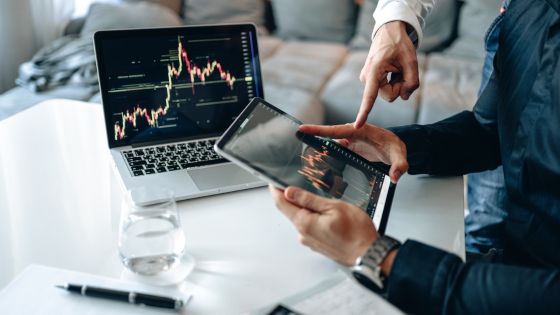In the current digital era, the trade business is undergoing tremendous transformation, which is causing a change in the guiding principles for creating new opportunities and simplifying operations. Artificial intelligence and big data analytics are just two of the disruptive innovations changing how we think about and deal with stocks and futures. Investors of today need to be very careful to understand and navigate these metamorphic trends, and staying informed through an options trading blog can be a valuable resource in this ever-evolving landscape.


The Role of AI in Trading
Dynamic models with the ability to analyze large volumes of data and make more precise trading choices have been made possible by machine learning. As traders learn patterns in the most active stocks, ML adapts over time to improve accuracy.
Predictive Analytics
Predictive analytics powered by artificial intelligence allows traders to forecast changes in the market. This predictive ability is obtained by looking at past data and current market conditions, which helps traders take advantage of market opportunities, lower risk, and make well-informed decisions.
Algorithmic Trading Strategies
Traders use a variety of types of algorithmic trading strategies to improve their decision-making abilities:
- Trend Following: This approach involves the utilization of indicators like moving averages to seize opportunities presented by market momentum.
- Statistical Arbitrage: Traders employing this strategy exploit pricing inefficiencies that arise between interconnected securities.
- Market Making: Here, traders continuously offer to buy and sell securities, aiming to profit from the bid-ask spread.
- High-Frequency Trading (HFT): In the realm of HFT, traders execute an extensive volume of orders within fractions of a second, with the objective of capitalizing on minute price differentials.
Case Studies
In recent times, companies such as Renaissance Technologies and Two Sigma have ascended to prominence through the adept utilization of cutting-edge algorithmic methodologies. Their triumphant narratives stand as compelling endorsements of the immense possibilities that arise from harnessing the prowess of computational capabilities and sophisticated algorithms to navigate the intricate nuances of the market landscape.
Big Data and Trading
Trading today goes beyond the conventional analysis of company reports and macroeconomic indicators. Traders now consider diverse data sources, including:
- Social Media Feeds: To gauge public sentiment and potential market reactions.
- Satellite Images: Monitoring things like retail parking spaces or agricultural yields.
- Web Scraping: Getting market intelligence in real time via scraping website data.
Data Analytics Tools
Modern trading systems naturally incorporate powerful analytical techniques for understanding complex information, allowing traders to glean useful knowledge. Traders may more accurately display, analyze, and predict market movements with the use of visualization tools like Tableau, Power BI, and R.
The Human Element in Trading
In the age of technical innovation, when advanced instruments and tactics rule supreme, it is critical to recognize the continuing value of human experience and intuition in the trading world. Automated systems are clearly superior in terms of speed and data processing, but human traders also provide a deeper understanding of context, moral judgment, and a broad view of the complex world of market scenarios.
The Future of Trader Roles
Future landscapes are about to experience a harmonic combination of human knowledge and technology. In this environment, roles may change: humans would play a bigger part in developing strategies, managing systems, and improving algorithms, while automated systems would handle everyday operations and the laborious process of data analysis.
Volatility of the Market and Technology
Advanced technological tools have emerged to help traders navigate the often unpredictable waves of market volatility. Through real-time data analytics and predictive modeling, traders can now get ahead of sudden market movements, preparing their portfolios for potential downturns and capitalizing on swift upswings.
Technology’s Role in Managing Volatility
Technology, especially AI-driven systems, aids traders in identifying early warning signs of market shifts. Large amounts of data are analyzed by these systems to produce alerts and suggestions that enable traders to proactively modify their holdings and approach.
Cybersecurity and Trading
The growing reliance of business on technology makes safeguarding digital infrastructures imperative. Complex firewalls, intrusion detection systems, and end-to-end encryption are used by modern trading businesses to protect sensitive transaction data and maintain the security of trading platforms.
Data Security Measures
By adding further security measures to the ones already in place to secure the underlying infrastructure, such as two-factor authentication, biometric verification, and regular security audits, traders and their clients may be protected against financial loss.
Globalization and Trading
Due to globalization, entrepreneurs today have several avenues to pursue successful ventures in foreign markets. Thanks to the availability of real-time information on sophisticated platforms covering global trends, currency movements, and geopolitical events, traders may now make informed decisions across borders.
Operating globally has advantages, but there are additional challenges as well, such adjusting to several time zones and understanding local market regulations. However, by offering means for effective international commerce, technical improvements have contributed to the closing of these disparities.
How Technology Is Shaping the Future of Stocks and Futures
Trading using technology is bringing about a shift in investment techniques. Tradespeople may now use technology that were previously only seen in science fiction, such as artificial intelligence, to their advantage and successfully negotiate the intricacies of international markets. However, development comes with a cost, and that cost is accountability. It is crucial to keep an eye on how to combine technology expertise with moral values and human judgment. Future trading has a lot of potential, but achieving it will require a well-rounded approach.























